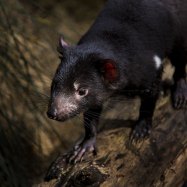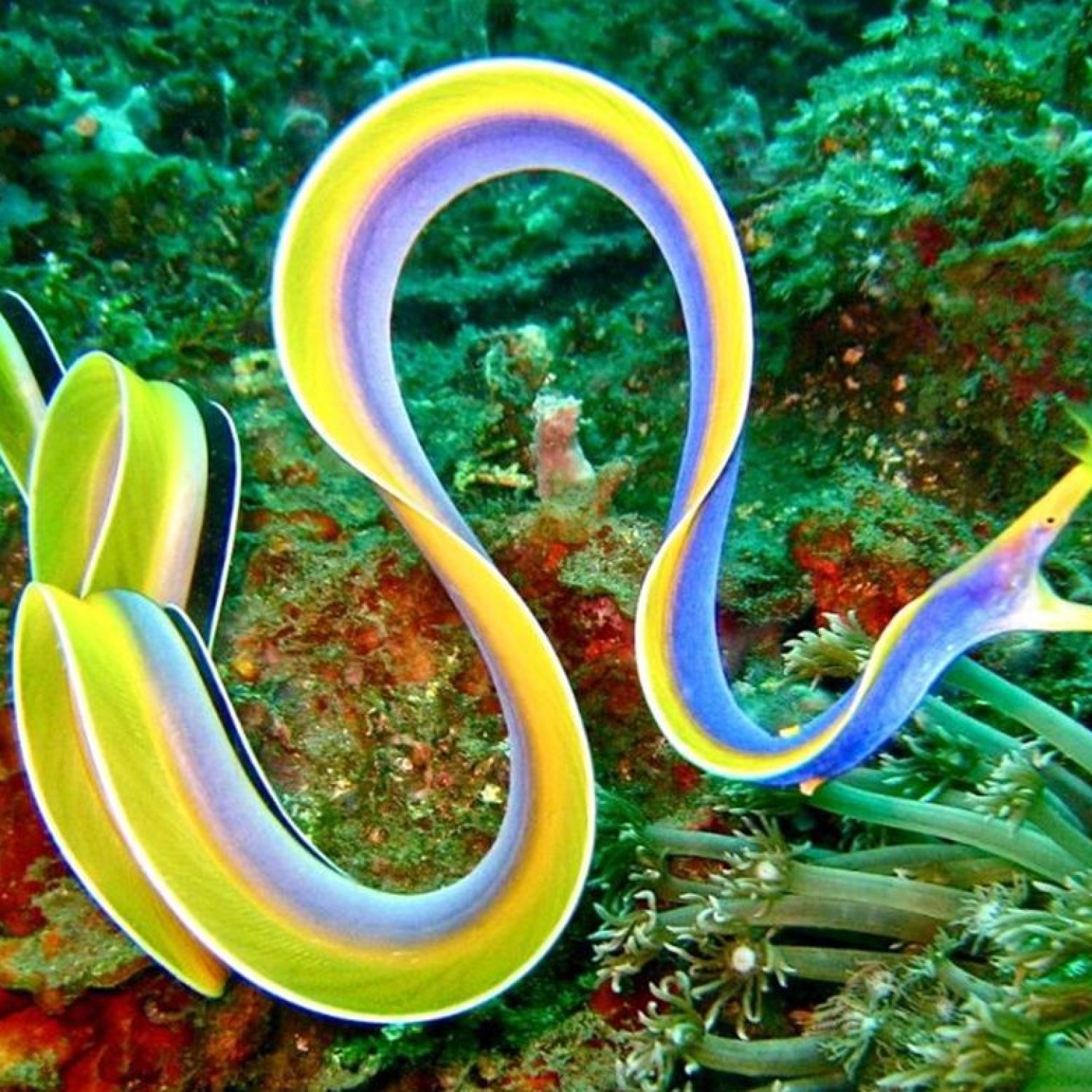
Ribbon Eel
Juvenile: 30-40 centimeters, Adult males: up to 1 meter, Adult females: up to 1.5 meters
Meet the fascinating Ribbon Eel, found in the tropical marine waters. Juveniles are 30-40cm, while males can grow up to 1m and females up to 1.5m. Their elongated, snake-like bodies and bright blue color make them a sight to behold in the ocean. Belonging to the Muraenidae family, these eels are both beautiful and unique! #RibbonEel #MarineLife #Muraenidae
Animal Details Summary:
Common Name: Ribbon Eel
Kingdom: Animalia
Habitat: Coral reefs
The Beautiful Ribbon Eel: Mystique and Majesty of the Coral Reefs
Descending into the depths of the ocean, one cannot help but be mesmerized by the vibrant colors and unique creatures that call these waters home. Among these fascinating beings is the Ribbon Eel, also known as Rhinomuraena quaesita. With its elongated and snake-like body, and striking coloration, this elusive creature has captured the imagination of many marine enthusiasts.The Ribbon Eel belongs to the kingdom Animalia, and is classified under the phylum Chordata Ribbon Eel. It is a member of the family Muraenidae, which is derived from the Greek word "muraina" meaning "eel". This family of eels is known for their long and slender bodies, with ribbon-like fins and jaws that can protrude outwards to catch their prey. The Ribbon Eel falls under the order Anguilliformes, which includes more than 800 species of eels, and is known for their snakelike shape.
One of the most distinctive features of the Ribbon Eel is its striking coloration. Juvenile Ribbon Eels have a black body with bright yellow or blue stripes, earning them the nickname "blue and yellow ribbon eels". However, as they mature, the males of the species develop a vibrant blue or black color, while the females turn a bright yellow. This difference in coloration is a phenomenon known as sexual dimorphism, which is common in many species of animals. These vibrant colors not only make the Ribbon Eel an intriguing sight for divers, but they also serve a purpose in the survival of the species. The bright blue color of adult males helps attract potential mates, while the yellow color of the females acts as a camouflage against predators in their natural habitat of coral reefs Rattlesnake.
Found primarily in the Indo-Pacific region, the Ribbon Eel can be found in the warm waters of the Indian and Pacific Oceans. They are commonly found in countries such as Indonesia, Australia, and the Philippines, where they tend to stick to the shallow waters of coral reefs. These eels prefer to make their homes in small holes or crevices within the reef, making them difficult to spot for even the most experienced divers. However, during the mating season, they can be seen roaming the open waters in search of a mate.
As a carnivorous species, the Ribbon Eel feeds on a diet of small fish and crustaceans such as shrimp and crabs. Using their powerful jaws and flexible bodies, they are able to hunt for prey and devour them whole. Due to their slender bodies, they are also able to sneak into small crevices within the coral reefs to catch their unsuspecting prey. This feeding method makes them an important part of the ecosystem, as they help control the population of small fish and maintain a balance within the coral reef.
Ribbon Eels are known for their reclusive nature and shy away from human contact. Due to their elusive nature, little is known about their behaviors and habits. However, studies have shown that they are primarily solitary creatures, only coming together during their short breeding season. They are also known to be highly territorial, fiercely defending their chosen home within the coral reef.
With an elongated body and ribbon-like fins, the Ribbon Eel is not built for speed. They rely on their flexible bodies and remarkable ability to blend in with their surroundings to evade predators. In addition to their vibrant colors, they also have the unique ability to change their coloration, making it easier for them to camouflage themselves within the coral reef and avoid detection.
The average length of a Ribbon Eel varies depending on their stage of life. Juveniles can grow to a length of 30-40 centimeters, while adult males can reach up to 1 meter and adult females can grow up to 1.5 meters. However, there have been reported sightings of even longer Ribbon Eels, with some measuring up to 2 meters in length. Despite their intimidating size, they are not considered a threat to humans and are generally harmless unless provoked.
Sadly, the Ribbon Eel is facing many challenges in their natural habitat. Due to the degradation of coral reefs, caused mainly by climate change and human activities, the population of Ribbon Eels has been declining over the years. Coral reefs provide shelter and food for these elusive creatures, and without them, they struggle to survive. Furthermore, they are also often caught as bycatch in fishing nets, further contributing to their decline. It is crucial that measures are taken to protect their natural habitat and ensure their survival for future generations.
In conclusion, the Ribbon Eel is truly a remarkable creature that adds to the mystique and majesty of the coral reefs. With its vibrant colors, unique behaviors, and elusive nature, it has captured the hearts of many marine enthusiasts. However, it is important that we take action to protect their natural habitat and ensure their survival. After all, the beauty and diversity of our oceans are what make them such fascinating and wondrous places. Let us all do our part in preserving it for generations to come.

Ribbon Eel
Animal Details Ribbon Eel - Scientific Name: Rhinomuraena quaesita
- Category: Animals R
- Scientific Name: Rhinomuraena quaesita
- Common Name: Ribbon Eel
- Kingdom: Animalia
- Phylum: Chordata
- Class: Actinopterygii
- Order: Anguilliformes
- Family: Muraenidae
- Habitat: Coral reefs
- Feeding Method: Carnivore
- Geographical Distribution: Indo-Pacific region
- Country of Origin: Indonesia, Australia, Philippines
- Location: Marine
- Animal Coloration: Juvenile: black with bright yellow or blue stripes, Adult males: blue or black, Adult females: yellow
- Body Shape: Elongated and snake-like
- Length: Juvenile: 30-40 centimeters, Adult males: up to 1 meter, Adult females: up to 1.5 meters
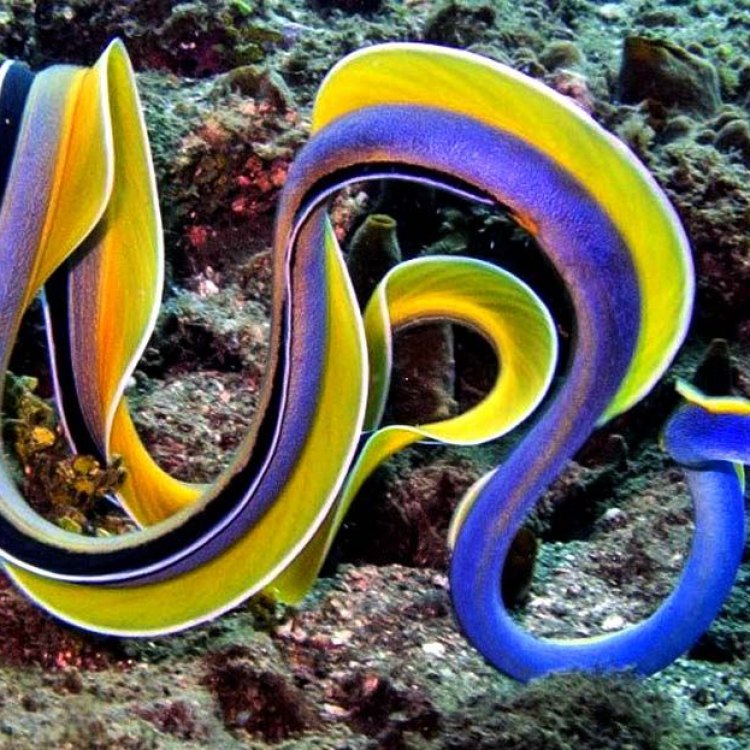
Ribbon Eel
- Adult Size: Up to 1.5 meters
- Average Lifespan: 10-15 years
- Reproduction: Sexual
- Reproductive Behavior: Protogynous hermaphrodite (born as females and change to males later in life)
- Sound or Call: Unknown
- Migration Pattern: Unknown
- Social Groups: Solitary
- Behavior: Shy and reclusive
- Threats: Habitat destruction, overfishing
- Conservation Status: Not evaluated
- Impact on Ecosystem: A predator that helps control the population of small fish in coral reef ecosystems
- Human Use: Collected for the aquarium trade
- Distinctive Features: Thin, ribbon-like body with a long, pointed snout
- Interesting Facts: The bright colors of the juvenile Ribbon Eels help them attract prey and blend in with their surroundings as they explore the reef.
- Predator: Larger fish and cephalopods
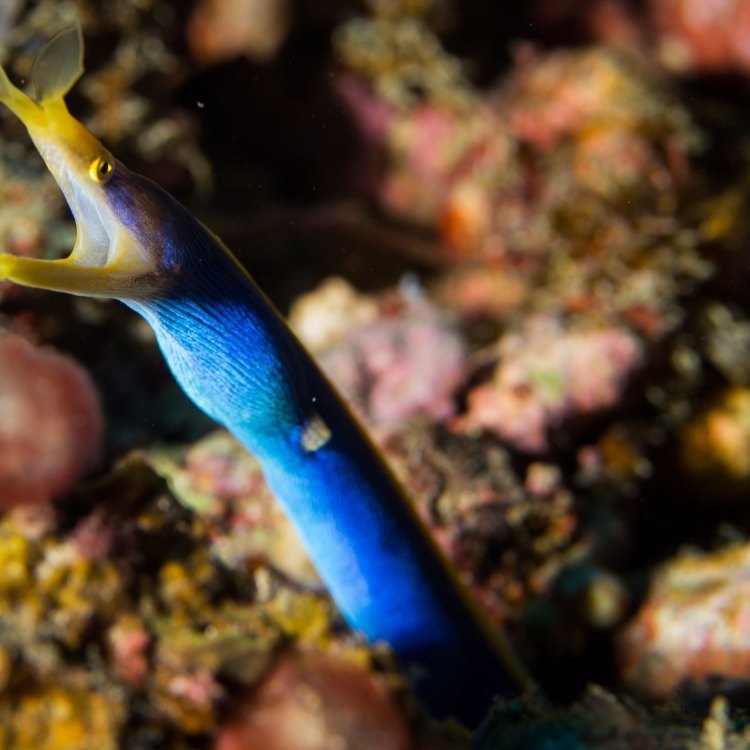
Rhinomuraena quaesita
The Enigmatic Ribbon Eel: A Mysterious and Colorful Creature of the Coral Reefs
Nestled among the vibrant and diverse ecosystems of the coral reef, hidden from the prying eyes of most divers, lies a creature shrouded in mystery – the Ribbon Eel. With its slender, ribbon-like body and striking colors, this elusive creature may seem like a work of art from a distance. But upon closer inspection, it reveals itself to be a fascinating and enigmatic creature with unique features and behaviors.In this article, we will dive into the world of the Ribbon Eel and learn more about its distinctive characteristics, behaviors, and role in the coral reef ecosystem PeaceOfAnimals.Com.
The Basics: Anatomy and Size
The Ribbon Eel, also known as the Leaf-Nosed Moray, is a species of moray eel (Family Muraenidae) found in the warm waters of the Indian and Pacific Oceans. It has a long, thin body that can grow up to 1.5 meters in length, making it one of the largest species of moray eel. However, despite its intimidating size, it poses no threat to divers as its small mouth and lack of teeth make it unable to inflict any harm.As with most eel species, the Ribbon Eel has a long, pointed snout and a set of sharp teeth used for grasping its prey. It also has a dorsal fin that extends the entire length of its body, giving it its distinctive ribbon-like appearance. Its body is covered in a slimy mucus layer, providing it with protection against parasites and bacteria.
The Life of a Ribbon Eel
The average lifespan of a Ribbon Eel is 10-15 years, with females having a slightly longer lifespan than males. Reproduction in this species is sexual, with males and females coming together to mate Rhamphosuchus. However, their reproductive behavior is what sets them apart from other eel species.Ribbon Eels are protogynous hermaphrodites, meaning they are born as females and transition to males later in life. As juveniles, they have bright colors, usually blue and yellow, to attract prey and blend in with their surroundings. But as they grow and reach sexual maturity, they change into dark brown or black males, with small white spots on their bodies.
This unique reproductive behavior has baffled scientists for years and is one of the reasons why the conservation status of the Ribbon Eel is currently not evaluated.
The Mysterious Call of the Ribbon Eel
One of the most intriguing mysteries surrounding the Ribbon Eel is its use of sound. While most eel species are known to produce low-frequency calls for communication or warning, the Ribbon Eel's sound or call remains unknown. Some scientists believe that the Ribbon Eel may not produce any sound at all, while others suggest that its smaller size and less muscular body may limit its ability to produce sounds.Further research is needed to understand the vocal abilities of this elusive creature and its role in communication within its species.
The Solitary Life of a Shy Creature
Unlike other eel species, Ribbon Eels are solitary creatures, spending most of their lives alone. They prefer to hide in crevices and holes, often peeking out with their heads poking out, giving them their reclusive behavior. This shyness may also be due to their lack of eyesight, as their small eyes are often covered by their slimy mucus layer.However, when approached or disturbed, Ribbon Eels can become aggressive and defend themselves by using their strong, muscular bodies to escape or their sharp teeth to bite.
Threats to the Ribbon Eel
Unfortunately, the Ribbon Eel is facing several threats in its natural habitat. Habitat destruction, pollution, and overfishing are the most significant threats to this species. As they are often found in shallow waters, they are at risk of being caught in fishing nets, significantly impacting their population.Moreover, their mucus layer is sensitive to changes in water quality, making them vulnerable to pollution and habitat destruction. If these threats continue unchecked, the Ribbon Eel's population may decline rapidly, leading to its extinction.
The Impact of the Ribbon Eel on the Ecosystem
Despite its shy and solitary nature, the Ribbon Eel plays an essential role in the coral reef ecosystem. As a predator, it helps control the population of small fish, maintaining balance in the delicate reef ecosystem. Their diet consists of fish, crustaceans, and cephalopods, making them valuable in regulating the population of these organisms.Additionally, their presence as an apex predator helps prevent overpopulation and overgrazing on the coral reefs, promoting a healthy and diverse ecosystem.
Human Use and Conservation Efforts
While the Ribbon Eel has not been evaluated for its conservation status by the International Union for Conservation of Nature (IUCN), its population may be declining due to habitat destruction and overfishing. The vibrant colors of juvenile Ribbon Eels make them a popular choice for the aquarium trade, making them a target for catching.It is essential to monitor and regulate the collection and trade of Ribbon Eels to ensure their population remains sustainable. Furthermore, efforts must be made to conserve and protect their natural habitats to support their survival and biodiversity in coral reef ecosystems.
The Distinct Features and Interesting Facts of the Ribbon Eel
Aside from its unique behavior and reproductive patterns, the Ribbon Eel also has distinctive physical features that make it stand out from other eel species. Its slender, ribbon-like body, coupled with its bright colors as a juvenile, makes it one of the most striking creatures in the coral reef.It's also fascinating to note that Ribbon Eels have been observed carrying their bodies out of the water and crawling on the seabed. This behavior is believed to be a way for them to travel short distances or avoid predators.
Another interesting fact about the Ribbon Eel is that its mucus layer not only protects it from external threats but also serves as a way for it to absorb oxygen from the water. This adaptation allows the Ribbon Eel to stay hidden for extended periods, emerging only for brief periods to breathe.
Predators of the Ribbon Eel
Like all creatures in the wild, the Ribbon Eel also has its share of predators. Larger fish, such as groupers and barracudas, and cephalopods, like octopuses and squids, are known to prey on Ribbon Eels. Their slimy mucus layer serves as a form of protection against these predators, but they are not entirely safe from their grasp.In Conclusion
The Ribbon Eel may not be as well-known as other creatures of the ocean, but its unique features and behaviors make it a fascinating and mysterious creature. As we continue to explore the vast and diverse world of the coral reefs, we must ensure that we protect and conserve these creatures, including the Ribbon Eel, for generations to come. Their presence is not only a visual delight but also an essential part of maintaining a healthy and balanced ecosystem. So let us marvel at the beauty of the Ribbon Eel and do our part in preserving its existence.
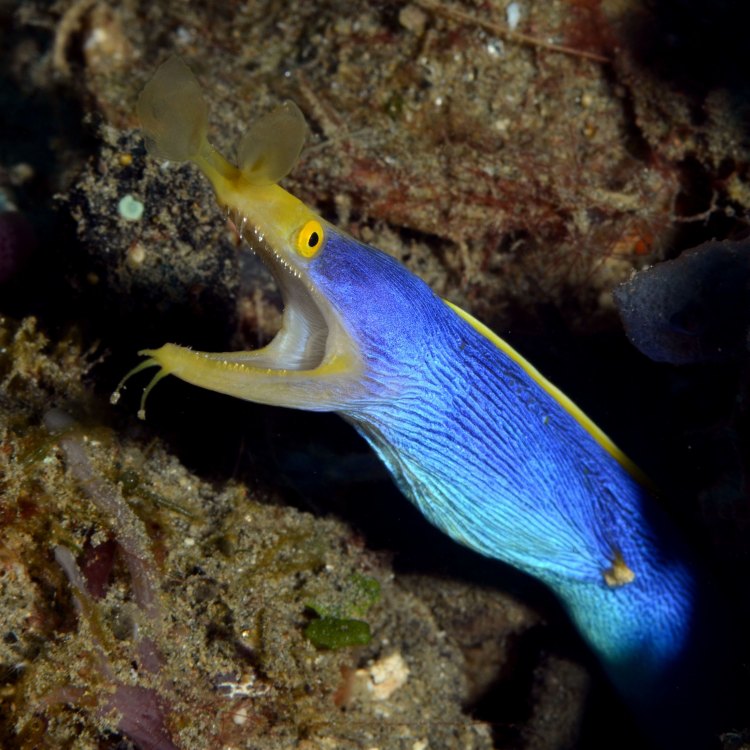
The Beautiful Ribbon Eel: Mystique and Majesty of the Coral Reefs
Disclaimer: The content provided is for informational purposes only. We cannot guarantee the accuracy of the information on this page 100%. All information provided here may change without prior notice.


